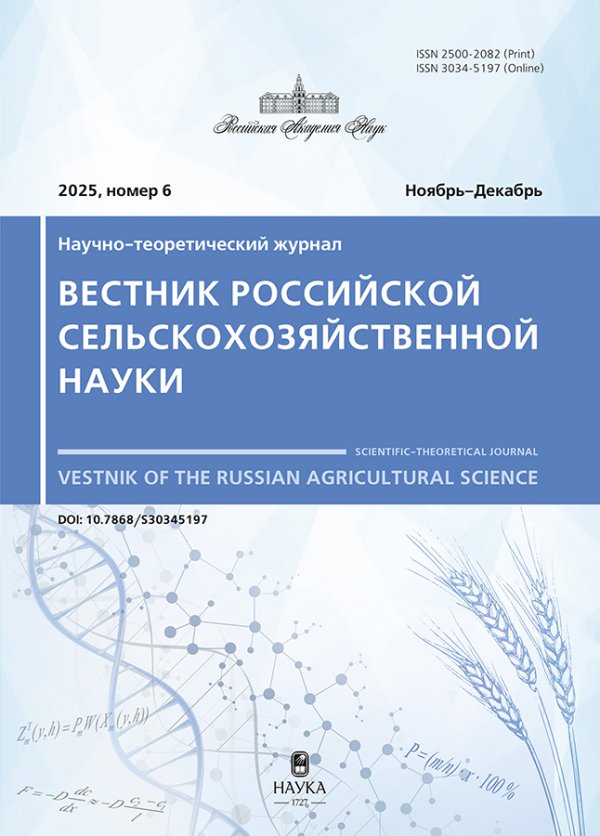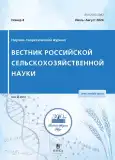Токсикологическая характеристика препарата Гиперико
- Авторы: Скляров О.Д.1, Рахматуллин Э.К.2, Бабичева О.В.1, Литвинов Н.А.1
-
Учреждения:
- Всероссийский государственный Центр качества и стандартизации лекарственных средств для животных и кормов
- ФГБНУ «Федеральный центр токсикологической, радиационной и биологической безопасности»
- Выпуск: № 4 (2024)
- Страницы: 99-101
- Раздел: Зоотехния
- URL: https://journals.rcsi.science/2500-2082/article/view/262861
- DOI: https://doi.org/10.31857/S2500208224040199
- EDN: https://elibrary.ru/xjqztb
- ID: 262861
Цитировать
Полный текст
Аннотация
В статье представлены результаты исследования токсичности препарата Гиперико. Установлено, что он малотоксичен и безопасен для животных при ежедневном применении, не провоцирует развитие патологических реакций. По классификации Hodge и Sterner (1943) Гиперико можно отнести к 6 классу токсичности – относительно безвреден. Значение ЛД50 препарата после внутрижелудочного введения белым крысам ≥ 36400, мышам – ≥ 45400 мг/кг, раздражения слизистых оболочек пищеварительного тракта не наблюдали. По ГОСТ 12.1.007.76 Гиперико относится к 4 классу опасности (малоопасные вещества). По результатам исследования можно сделать обоснованное заключение о том, что изучаемый препарат не оказывает токсического действия на телят, противопоказаний для проведения клинических исследований нет.
Ключевые слова
Полный текст
В животноводческих хозяйствах Российской Федерации примерно у 70…80% телят в первые дни жизни развивается диспепсия (летальность может достигать 75%). Ущерб определяется стоимостью павших животных, лечения заболевших, а также тем, что при одном и том же рационе переболевший молодняк дает значительно меньший прирост. Диспепсия новорожденных телят – одно из наиболее сложных полиэтиологических заболеваний и требует глубокого анализа с установлением причин возникновения, способов устранения и реализации эффективных мер профилактики. [2, 5, 6, 9]
Широко применяют антибиотикотерапию и избирательное подавление возбудителя. Терапия желудочно-кишечных заболеваний телят с бесконтрольным использованием различных антибиотиков, сульфаниламидов и нитрофуранов вызывает дисбактериоз и подавляет жизнедеятельность полезной микрофлоры, замедляет процесс выздоровления животных.
Цель работы – доказать безопасность фитопрепарата Гиперико на основе зверобоя для телят.
МАТЕРИАЛЫ И МЕТОДЫ
Приготовление Гиперико (фитопрепарат на основе Зверобоя продырявленного): 300 г травы зверобоя помещали в марлю, заливали 6…7 л кипятка и остужали до 70°С; добавляли 250 г глюкозы, 50 г натрия хлорида, 10 г лактата кальция, 5 г аскорбиновой кислоты и 220 г натрий карбоксиметилцеллюлозы (бланоза). После растворения этих компонентов объем раствора доводили до 10 л добавлением воды (70°С); оставляли на 12…15 ч при комнатной температуре, периодически перемешивая. Перед применением препарат подогревали до 37…38°С и встряхивали до образования однородной массы. [7] Использовали в дозе 6,5 мл/кг с добавлением 0,5…0,7 л теплой воды в течение шести суток после приготовления.
Изучали действие Гиперико в соответствии с рекомендациями по проведению доклинических исследований лекарственных средств. [6]
Белым крысам-самцам массой 210…245 г внутрижелудочно с помощью атравматичного металлического зонда вводили Гиперико (18200 и 24400 мг/кг), мышам-самцам (21,0…24,5 г) – 22700 и 45400 мг/кг. Для каждой дозы брали шесть крыс и пять мышей. Шести крысам контрольной группы вводили дистиллированную воду. ЛД50 рассчитывали методом пробит-анализа, предложенным Личфилдом-Уилкоксоном в модификации З. Рота.
За общим состоянием животных, проявлением или отсутствием симптомов интоксикации следили в течение 14 дн., отмечали особенности поведения, приема пищи и воды, оценивали состояние шерсти, выполнение физиологических функций. Затем подопытных крыс подвергали эвтаназии и патологоанатомическому исследованию.
Для изучения влияния Гиперико на монооксигеназную ферментативную систему печени использовали теопенталовый тест. [10] Он предполагает усыпление животных тиопенталом на время, эквивалентное функциональной активности монооксигеназной ферментной системы печени. Для этого сформировали из 48 крыс-самок двухмесячного возраста восемь групп. Крыс погружали в тиопенталовый сон через 1, 3, 5 и 24 ч после однократного применения препарата. Тиопентал вводили внутрибрюшинно (40 мг/кг). Продолжительность «тиопенталового сна» фиксировали в минутах. Начало – момент принятия животными «бокового положения», окончание – первые попытки изменить его.
Изучение действия Гиперико на гемотологические показатели проводили на телятах черно-пестрой породы. Были скомплектованы две группы по шесть голов здоровых телят пяти-семидневного возраста со средней массой 33,45…35,12 кг. Перед применением препарат тщательно перемащивали с водой и давали животным в дозе 6,5 мл/кг в течение шести дней. Телятам контрольной группы давали воду. Для изучения влияния Гиперико на гематологические параметры телят определяли количество эритроцитов, лейкоцитов, гемоглобина и скорость оседания эритроцитов (СОЭ). Кровь для исследования брали до применения препарата и на 1-е, 5-е, 15-е и 30-е сут. после.
Содержание и уход за экспериментальными животными проводили согласно ГОСТ 33216-2014. [4]
Полученные экспериментальные данные обрабатывали методом вариационной статистики в программе STATISTICA. Значимость различий устанавливали по величине критерия Стьюдента.
РЕЗУЛЬТАТЫ
Острые расстройства пищеварения у молодняка в раннем постнатальном периоде развития свидетельствуют о наличии в племенном стаде заболеваний, связанных с нарушением обмена веществ, который у растущих животных характеризуется значительной интенсивностью, поэтому они очень чувствительны к нарушениям условий содержания и кормления. При внутрижелудочном введении крысам доз 18200 и 36400 мг/кг, мышам – 22700 и 45400 мг/кг летальных последствий не зарегистрировали (табл. 1).
Таблица 1.
Токсичность препарата Гиперико при внутрижелудочном введении лабораторным грызунам
Животное | Значение | Результат | |
Крыса | Доза, мг/кг | 18200 | 36400 |
Объем вводимого раствора, мл/кг | 18,2 | 36,4 | |
Эффект, пало/всего | 0/6 | 0/6 | |
Мышь | Доза, мг/кг | 22700 | 45400 |
Объем вводимого раствора, мл/кг | 22,7 | 45,4 | |
Эффект, пало/всего | 0/6 | 0/6 | |
Существенных нарушений в общем состоянии и поведении животных также не было. В первые сутки у грызунов появились небольшая жажда и снижение аппетита, что, по-видимому, связано не с токсическим действием препарата, а со стрессом во время процедуры перорального введения больших объемов. Во все дни наблюдения подопытные животные по общему состоянию и поведению не отличались от контрольных. Через две недели после действия Гиперико особи, пережившие интоксикацию, не отличались от контрольных.
Значения ЛД50 препарата при внутрижелудочном введении белым беспородным крысам и белым мышам определить невозможно, они заведомо ≥ 36400 и ≥ 45400 мг/кг соответственно.
Раздражение слизистых оболочек пищеварительного тракта при внутрижелудочном введении препарата не наблюдалось.
Таким образом, результаты токсикометрии, данные наблюдения за экспериментальными животными в период после введения, а также данные патоморфологических исследований позволяют отнести Гиперико по классификации токсичности Hodge и Sterner к 6 классу (относительно безвредные лекарственные средства). [11]
По ГОСТ 12.1.007.76 препарат принадлежит к малотоксичным (4 класс опасности). [2, 3] Состояние животных свидетельствует о хорошей переносимости препарата и его безвредности.
Печень играет важную роль во многих видах обмена веществ (белковый, углеводный, липидный, пигментный), процессах свертывания крови, осуществляет обезвреживающую и выделительную функции. Метаболизируя токсичные химические соединения, клетки печени становятся мишенью их действия.
При расстройстве пищеварения в значительной степени поражается печень. Через нее проходят все вещества, которые всасываются из кишечника в кровь.
Из данных таблицы 2 видно, что введение Гиперико в дозах 6500 и 13000 мг/кг не приводило к угнетению антитоксической функции печени. Инъекция тиопентала через 1, 3, 5 и 24 ч не влияла на продолжительность сна подопытных крыс в отличие от контрольных (P > 0,05).
Таблица 2.
Продолжительность тиопенталового сна крыс после введения Гиперико
Гиперико, мг/кг | Группа (время инъекции тиопентала, ч) | |||
I (1) | III (3) | III (5) | IV (24) | |
Продолжительность сна, мин. | ||||
6500 | 27,0 ± 7,58 | 27,8 ± 6,09 | 26,5 ± 4,77 | 28,6 ± 7,29 |
V | VI | VII | VIII | |
13000 | 28,1 ± 6,71 | 29,1 ± 5,12 | 28,6 ± 4,82 | 27,4 ± 6,32 |
Контроль | 26,4 ± 5,47 | 26,4 ± 5,47 | 26,4 ± 5,47 | 26,4 ± 5,47 |
Примечание. P > 0,05.
Таким образом, можно сделать заключение о том, что Гиперико не угнетает антитоксическую функцию печени.
При ежедневном пероральном введении телятам дозы Гиперико (6,5 мл/кг) общее состояние и поведение животных не изменялось.
После внутрижелудочного введения телятам Гиперико (6,5 мл/кг) происходят несущественные колебания гематологических показателей (табл. 3).
Таблица 3.
Гематологические показатели телят до и после введения Гиперико
Показатель | До введения | После введения, сут. | |||
1-е | 5-е | 15-е | 30-е | ||
Эритроциты, × 1012 /л | 5,44 + 0,23 | 5,53 + 0,49 | 5,17 + 0,26 | 5,22 + 0,19 | 5,02 + 0,63 |
5,15 ± 1,16 | 5,05 ± 0,28 | 5,05 ± 0,28 | 5,15 ± 1,16 | 5,15 ± 1,16 | |
Гемоглобин, г/ л | 98,9 + 5,32 | 102,4 + 10,53 | 92,6 + 6,12 | 93,7 + 4,34 | 90,8 + 6,41 |
88,6 ± 3,02 | 89,3 ± 7,36 | 89,3 ± 7,36 | 90,6 ± 3,02 | 90,6 ± 3,02 | |
Лейкоциты, × 109 /л | 7,97 + 1,12 | 7,47 + 1,14 | 8,15 + 0,91 | 8,18 + 0,66 | 9,10 + 0,83 |
7,85 ± 1,34 | 7,65 ± 1,34 | 7,65 ± 1,34 | 7,85 ± 1,34 | 7,85 ± 1,34 | |
СОЭ, Мм/ ч | 1,42 + 0,25 | 1,55 + 0,23 | 1,37 + 0,61 | 1,27 + 0,14 | 1,51 + 0,2 |
1,25 ± 0,22 | 1,33 ± 0,44 | 1,33 ± 0,34 | 1,25 ± 0,22 | 1,25 ± 0,22 | |
Примечание. Числитель – показатели опытных животных, знаменатель – контрольных.
По результатам исследования можно сделать заключение о том, что Гиперико безопасный препарат и не оказывает токсического действия на телят.
Об авторах
Олег Дмитриевич Скляров
Всероссийский государственный Центр качества и стандартизации лекарственных средств для животных и кормов
Автор, ответственный за переписку.
Email: scliarov@yandex.ru
доктор ветеринарных наук
Россия, МоскваЭмиль Касымович Рахматуллин
ФГБНУ «Федеральный центр токсикологической, радиационной и биологической безопасности»
Email: scliarov@yandex.ru
доктор ветеринарных наук
Россия, КазаньОлеся Викторовна Бабичева
Всероссийский государственный Центр качества и стандартизации лекарственных средств для животных и кормов
Email: scliarov@yandex.ru
ведущий научный сотрудник
Россия, МоскваНиколай Александрович Литвинов
Всероссийский государственный Центр качества и стандартизации лекарственных средств для животных и кормов
Email: scliarov@yandex.ru
ведущий специалист
Россия, МоскваСписок литературы
- Березовская И.В. Классификация химических веществ по параметрам острой токсичности при парентеральных способах введения // Химико-фармацевтический журнал. 2003. Т. 37. № 3. С. 32–34.
- Вахрушева Т.И. Анализ заболеваемости молодняка крупного скота внутренними незаразными патологиями в АО ПЗ «Краснотуранский» Красноярского края // В сб. Всерос. науч. конф. г. Новосибирск: ИЦ ИНГАУ «Золотой Колос», 2019. С. 194–197.
- ГОСТ 12.1.007-76. Межгосударственный стандарт. Система стандартов безопасности труда. Вредные вещества. Классификация и общие требования безопасности. Дата введения 01.01.1977.
- ГОСТ 33216-2014 «Руководство по содержанию и уходу за лабораторными животными»
- Кондрахин И.П., Таланов Г.А., Пак В.В. Внутренние незаразные болезни животных. М.: КолосС, 2003. 461 с.
- Павлов Д.К. Заболевания желудочно-кишечного тракта у новорожденных телят // Ветеринарная жизнь. 2006. № 11. С. 12–14.
- Рахматуллин Э.К., Скляров О.Д. Препарат для лечения и профилактики острых желудочно-кишечных болезней новорожденных телят. Патент на изобретение 2740602 C1, 15.01.2021. Заявка № 2020107209 от 17.02.2020.
- Руководство по проведению доклинических исследований лекарственных средств. Часть первая. Под общей редакцией доктора медицинских наук А.Н. Миронова. М.: Гриф и К, 2012. 944 с.
- Смоленцев С.Ю. Методы лечения расстройства пищеварения телят (обзор) // Вестник Марийского государственного университета. Серия «Сельскохозяйственные науки. Экономические науки». 2022. Т. 8. № 3. С. 280–287. https://doi.org/10.30914/2411-9687-2022-8-3-280-287
- Хабриев Р.У. Руководство по экспериментальному и доклиническому изучению новых фармакологических веществ. 2-е изд., перераб. и доп. М.: ОАО «Издательство “Медицина”», 2005. 832 с.
- Hodge H.C., Gosselin R.E., Smith R.P., Gleason M.N. Clinical Toxicology of Commercial Products // Acute Poisoning. 4th ed., Williams & Wilkins, Baltimore. 1975. 427 p.
Дополнительные файлы










